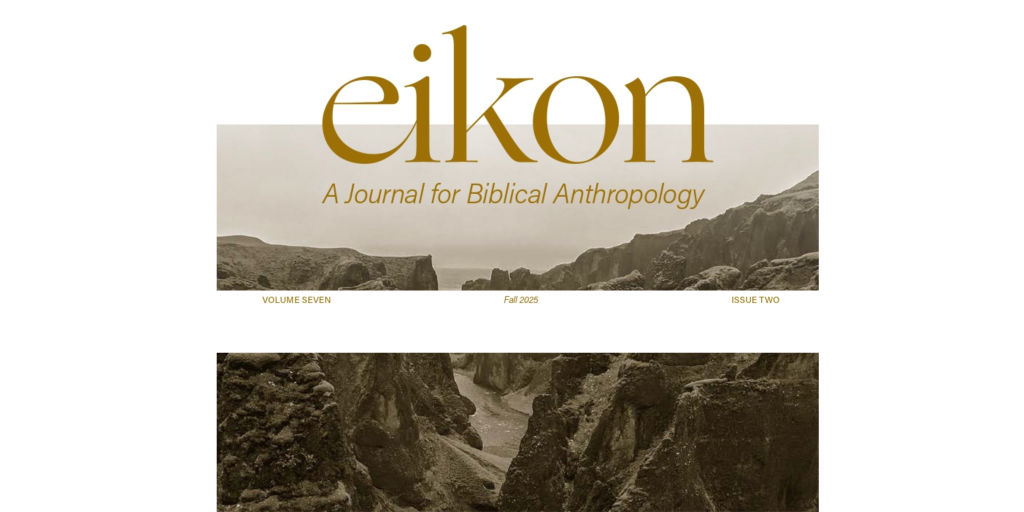
Editor’s Note: The following excerpt appears in the Fall 2025 issue of Eikon.
At the turn of the twentieth century, Dutch theologian Herman Bavinck (1854–1921) found himself confronted by a society increasingly hostile to human flourishing according to divine design. Sufficiently alarmed, he busied himself with a counteroffensive, which has been passed down to the anglophone world under the title, The Christian Family. The family was in trouble, and one of the most influential theologians of the Christian era unsheathed his pen in defense knowing it was a matter of civilizational life or death.[1]
What Bavinck wrote then is just as relevant today, so in this issue on anthropology, we share his section on “The Distinction Between Man and Woman” as an exemplary handling of biblical anthropology, which exalts in God’s good design in creating humans in his image male and female.[2]
The Distinction between Man and Woman
Nevertheless, we can both underestimate and overestimate this distinction. The first defect often hobbled people in previous centuries. In practice people frequently viewed the woman as a being of lower order than the man, and theoretically people often denied her the status of being fully human. Over against that view, we must maintain, with the help of Scripture which alone supplies an explanation regarding the origin and essence of a human being, that both man and woman are created in God’s image, and that therefore both are human beings in the fullest sense of the term. The second chapter of Genesis presents the woman especially as a helper suitable for the man, but let us not forget that this chapter has been preceded by the first chapter of Genesis. Here we read that God created man and woman together in his image; the woman can be a helper suitable for the man only because she is his equal and reflects God’s image just as much as he does. The question that has been raised upon occasion in the past, namely, whether the woman may be called a human being, is not at all appropriate. The woman is a human being no less than the man, because she no less than he was created in God’s image. Scripture speaks in a very human way about the essence of God, but it never transfers the sexual differentiation to him; God is never portrayed or presented as being feminine. But if the woman is said to be created along with man in the image of God, then that includes the fact that the uniqueness and richness of feminine qualities no less than those of the masculine capacities find their origin and example in the divine Being. God is a Father who takes pity on his children, but he also comforts like a mother comforts her son.
Because of this unity of human nature, then, the well-known saying is not entirely true that claims that the man is incomplete and half a person without the woman, and the woman without the man. It is true only insofar as each is viewed separately in his or her own particularity. But the expression is less correct when one thinks of human nature, which is common to both. Each of the two is complete as a person. Man and woman each have a soul and a body, a mind and a will, a heart and a conscience, a spirit and a personality. There is no single capacity of the body and no single quality of the soul that is exclusively unique either to the man or to the woman. Each of the two has a fully human nature and is a uniquely independent personality. For that reason, the question is so difficult to answer as to whether the woman possesses less of an aptitude for some activities and functions than the man. For although understanding and rationality, head and hand, undoubtedly function in a different way with the woman than with the man, that does not at all imply either a different or an inferior aptitude, and is not at all identical to inability. Related to this is the difficulty of describing crisply and clearly the distinction between man and woman. Judgments span a wide range, and it requires no artistry to arrange alongside one another the contradictory opinions of those with profound understanding of human nature.
Down through the centuries and among all nations, among philosophers and among the unreflective masses, women haters have exchanged places with women worshippers. And men have hardly remained constant in their own judgment, but frequently move from the one to the other extreme. At one time or another, the woman is an angel or a devil, a queen or a vixen, a dove or a serpent, a rose or a thorn. The feminine is identified as divine, and then again as demonic. The man kneels before her in worship, only then to pin her under his foot. Frequently the conclusion is that the woman is a riddle; the man does not understand her, and yet he often understands her even better than she knows herself. Nevertheless, the distinction exists, and it is set in terms of its main features as well. There is outward difference between man and woman, in terms of the body and all of its organs. Difference in the size of the head, in the development and weight of the brain, in the tint of the skin, in the growth of hair, in the shape of breast and stomach, in the form of the hands and feet. Difference also with regard to the strength and tone of the muscles, the sensitivity of the nervous system, the gracefulness of movements, the color of the blood, the flow of tears, the pulse rate, the sound of the voice, the multiplicity of needs, the capacity to suffer, the weight and strength of the body. In her entire development, the woman is closer to the child and reaches full adulthood sooner than the man.
No less important is the distinction between man and woman that exists in the life of the soul. People have said that the soul has no sexual differentiation, but even though the nature and capacities of the soul are the same for man and woman, they function in a different way. By means of observation the woman acquires sense impressions more quickly and retains them longer and more deeply than the man. Her imagination is characterized by greater liveliness and quicker connectivity. Her thinking and evaluating are characteristically more visual than analytic, attaching more value to the amenities of life than to abstract principles and rules. She seeks truth preferably along the route of an idealizing view of reality, rather than by the method of conceptual analysis. With the man, the volitional capacity is more logical, more capable of persistence, more persevering in striving for a goal, but the woman surpasses him in forbearance and patience, in the capacities for suffering and adapting.
The human nature given to man and woman is one and the same, but in each of them it exists in a unique way. And this distinction functions in all of life and in all kinds of activity. Already the outward appearance of the woman makes an entirely different impression than that of the man, and has an entirely different significance for her than for him. Clothes and jewelry are less important for the man, but with the woman they are an important part of her life. For that reason people often call women “the fairer sex.” That entails no insult, as long as it does not intend to portray the masculine sex as “the ugly sex.” For just as the description of women as “the weaker sex” [1 Peter 3:7] does not imply that all forms of weakness are combined in the woman, similarly the description of women as “the fairer sex” does not imply that all beauty has been bestowed on the woman. The man is beautiful as well. Only an unhealthy school of thought relating to beauty and art acknowledges no higher beauty than that of a naked female body, time and again abusing her in various seductive and hideous poses as though she were nothing more than an ornament. Such an unhealthy school of thought also entails that people no longer have an eye for the beauty of the man. Yet, such beauty exists as well. It is a different beauty, quite surely, but of no less value. It is the beauty of loftiness that the man embodies, even as the beauty of comeliness is the possession of the woman. But both man and woman are beautiful; both display the features of the image of God in which they are created.
To the man belongs the strength of physical prowess, the wide chest, the commanding eye, the full beard, the powerful voice; to the woman belongs a delicate shape, sensitive skin, full bosom, round shape, soft voice, long hair, elegant carriage, and supple movement. He engenders respect, she engenders tenderness. In terms of beauty, Michelangelo’s Moses is not inferior to Raphael’s Madonna. Similarly, the woman is constructed differently than the man in terms of religion, intellect, and morality. The same laws of logic and morals, the same religion and morality apply to both. The man is not intellectually superior to the woman, and the woman is not morally superior to the man. But how entirely different each of them takes hold of religion and morality, art and science! The man sees in religion first of all a duty, the woman considers it a pleasure and a privilege. For the man, the good functions more in the form of justice, for the woman it takes the shape of love. The man wants justice and law, the woman sympathy and participation. The man strives for the truth of an idea, the woman pursues the reality of life.
Accordingly, each must be on guard for a particular set of sins. The man must struggle against forcing his principles and pressing upon others every possible consequence, and the woman must wrestle continually against her deficiency in logic that is manifested both in rigid tenacity and incorrigible willfulness, as well as in a fickleness that defies every form of argument. The man is susceptible to the danger of doubt and unbelief, rationalism and dead orthodoxy, while the woman risks no less a danger of superficial piety and superstition, mysticism and fanaticism. The loquaciousness of the woman contrasts with the incommunicativeness of the man. The vanity of the woman is no worse than the coarse indifference of the man. The infidelity of the man is matched by the stubbornness of the woman. Indeed, man and woman have nothing to hold against each other. Each has quite glorious virtues and each has rather serious defects. There is room for neither disparagement nor deification with respect to either of them.
[1]For more on Bavinck’s The Christian Family, see Colin Smother’s summary and commendation of the work in “Recovering Bavinck’s ‘The Christian Family’” in Eikon: A Journal for Biblical Anthropology 3.1 (Spring 2020):8–15.
[2]The following text is excerpted from Herman Bavinck, The Christian Family, translated by Nelson D. Kloosterman (Grand Rapids, MI: Christian’s Library Press, 2012), 65–70. Used with the publisher’s permission.
Share This Article


